
M
M
T
T
9
9
3
3
0
0
B
B
S
S
e
e
r
r
v
v
i
i
c
c
e
e
M
M
a
a
n
n
u
u
a
a
l
l
P
P
a
a
g
g
e
e
8
8
-
-
1
1
CHAPTER 8
TROUBLESHOOTING PROCEDURES
SOLVING TYPICAL PROBLEMS
Typical C-band problems are terrestrial interference (TI), poor carrier-to-noise
(C/N) ratio, and cable loss. These are discussed in the following paragraphs.
See Chapter 3, Figures 3-1 or 3-2 for references to controls in parentheses.
Terrestrial Interference
For mild TI (on one side only), rotate the FINE TUNE control (6) right or left
(adjusting for best picture) to step the interference off the side of the bandpass
filter. The AFC switch (5) can be left ON, but if the TI becomes too strong, the
AFC will try to tune to the TI. If this occurs, slide the AFC switch to OFF. The
MT900 rear panel 70 MHz TRAP connectors (27) allow insertion of notch filters
at 60 MHz and 80 MHz. SCC suggests the use of Microwave Filter Company
(telephone 1-800-448-1666) part number 4616-70F. TI can also be suppressed
by inserting external, tunable filters in the 950 to 1450 MHz input line. SCC
recommends Microwave Filter Company part numbers 5316 (to 1450 MHz) or
8976 (to 1750 MHz).
NOTE:
Notch loss for the 8976 filter at 5.0 MHz is 12 dB (max); at 5.5 MHz
it is 3 dB. For the 5316, the loss is 18 dB.
For severe TI, passive blocking, such as screens or mounds of earth, should be
installed to shield the antenna.
Poor C/N Ratio
A dynamic C/N ratio of approximately 12.5 dB must be provided at the RF input
to the receiver. If the C/N ratio falls below this level, impulse noise (sparkles) will
start to appear in the picture, usually in the reds and in character-generated
letters.
Cable Loss
The RF signal at the receiver input must be at least –60 dBm. The average
amplitude at the back of the an antenna dish at C-band is approximately –43 dBm.
RG-6U coaxial cable has an approximate seven (7) dB loss per 100 feet, so the
maximum cable run without using line amplifiers is approximately 200 feet.
Summary of Contents for mt930b
Page 3: ...MT930B Service Manual Page i ...
Page 10: ...General Information Page 1 4 Service Manual MT930B THIS PAGE INTENTIONALLY LEFT BLANK ...
Page 22: ...Controls and Connections Page 3 4 Service Manual MT930B THIS PAGE INTENTIONALLY LEFT BLANK ...
Page 86: ...Options Maintenance Page 7 2 Service Manual MT930B THIS PAGE INTENTIONALLY LEFT BLANK ...
Page 90: ...Drawings Page 9 2 Service Manual MT930B 10264 Figure 9 1 MT930B Block Diagram 1 ...
Page 91: ...Drawings MT930B Service Manual Page 9 3 10265 Figure 9 2 MT930B Block Diagram 2 ...
Page 92: ...Drawings Page 9 4 Service Manual MT930B 10266 Figure 9 3 MT930B Block Diagram 3 ...
Page 93: ...Drawings MT930B Service Manual Page 9 5 10267 Figure 9 4 MT930B Block Diagram 4 ...
Page 94: ...Drawings Page 9 6 Service Manual MT930B 10268 Figure 9 5 MT930B Head Phone Schematic ...
Page 95: ...Drawings MT930B Service Manual Page 9 7 10269 Figure 9 6 MT930B RF PC Board Schematic ...
Page 96: ...Drawings Page 9 8 Service Manual MT930B 10270 Figure 9 7 MT930B Converter Module Schematic ...
Page 97: ...Drawings MT930B Service Manual Page 9 9 10271 Figure 9 8 MT930B Main PC Board Sheet 1 of 3 ...
Page 98: ...Drawings Page 9 10 Service Manual MT930B Figure 9 9 MT930B Main PC Board Sheet 2 of 3 ...
Page 99: ...Drawings MT930B Service Manual Page 9 11 10273 Figure 9 10 MT930B Main PC Board Sheet 3 of 3 ...
Page 100: ...Drawings Page 9 12 Service Manual MT930B 10274 Figure 9 11 MT930B Power Supply Schematic ...
Page 101: ...Drawings MT930B Service Manual Page 9 13 10275 Figure 9 12 MT930B IF Filter Block Schematic ...
Page 102: ...Drawings Page9 14 Service Manual MT930B 10276 Figure 9 13 MT930B Audio IF PB01 Schematic ...
Page 103: ...Drawings MT930B Service Manual Page 9 15 10277 Figure 9 14 MT930B Audio Out Schematic ...
















































